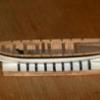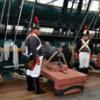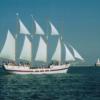
Roger Pellett
-
Posts
4,519 -
Joined
-
Last visited
Reputation Activity
-
 Roger Pellett got a reaction from Old Collingwood in HMS Argonaut (F56) by crabbersnipe - 1/96th - Leander-class frigate
Roger Pellett got a reaction from Old Collingwood in HMS Argonaut (F56) by crabbersnipe - 1/96th - Leander-class frigate
Over the past 25 years I have used several gallons of West System epoxy repairing boats for our community sailing association, restoring wood canvas canoes, and building a glued lap strake canoe. I have found the product to be easy to work with and 100% reliable.
For glassing your hull you will probably want the longer pot life that you get from the slow cure version, but the resins are interchangeable so if you later have an application for a faster cure all that you have to do is buy the fast cure hardener.
Be sure to buy a pair of the correct West System mini pumps. These allow you to dispense resin and hardener in the correct ratio. Mixing resin and catalyst in the correct ratio ensures success.Despite commonly held belief, more hardener is not better! It just means that you will end up with a gooey mess.
One criticism of West System is the amine blush that forms on the surface of their cured resin. This can interfere with curing of subsequent coatings. For a small application like yours this will not present a problem as a light sanding will remove it. Something that you will probably want to do anyhow.
Roger
-
 Roger Pellett got a reaction from skipper1947 in Rigging instructions are the worst...and I have another question.
Roger Pellett got a reaction from skipper1947 in Rigging instructions are the worst...and I have another question.
The line in question is called a vang. It's purpose is to prevent the gaff from sagging to leeward causing the sail to twist, an inefficient shape. Vangs were rigged in pairs. The windward one would be set up to control the gaff and the leeward one slacked off. When the sail was not set, by setting up both vangs the gaff could be left "standing," not lowered. The sail could be then brailed up to the gaff and mast.
Yes, you need to rig two gangs, port and starboard.
Roger Pellett
-
 Roger Pellett got a reaction from mtaylor in Rigging instructions are the worst...and I have another question.
Roger Pellett got a reaction from mtaylor in Rigging instructions are the worst...and I have another question.
The line in question is called a vang. It's purpose is to prevent the gaff from sagging to leeward causing the sail to twist, an inefficient shape. Vangs were rigged in pairs. The windward one would be set up to control the gaff and the leeward one slacked off. When the sail was not set, by setting up both vangs the gaff could be left "standing," not lowered. The sail could be then brailed up to the gaff and mast.
Yes, you need to rig two gangs, port and starboard.
Roger Pellett
-
 Roger Pellett got a reaction from Canute in Rigging instructions are the worst...and I have another question.
Roger Pellett got a reaction from Canute in Rigging instructions are the worst...and I have another question.
The line in question is called a vang. It's purpose is to prevent the gaff from sagging to leeward causing the sail to twist, an inefficient shape. Vangs were rigged in pairs. The windward one would be set up to control the gaff and the leeward one slacked off. When the sail was not set, by setting up both vangs the gaff could be left "standing," not lowered. The sail could be then brailed up to the gaff and mast.
Yes, you need to rig two gangs, port and starboard.
Roger Pellett
-
 Roger Pellett got a reaction from davyboy in Rigging instructions are the worst...and I have another question.
Roger Pellett got a reaction from davyboy in Rigging instructions are the worst...and I have another question.
The line in question is called a vang. It's purpose is to prevent the gaff from sagging to leeward causing the sail to twist, an inefficient shape. Vangs were rigged in pairs. The windward one would be set up to control the gaff and the leeward one slacked off. When the sail was not set, by setting up both vangs the gaff could be left "standing," not lowered. The sail could be then brailed up to the gaff and mast.
Yes, you need to rig two gangs, port and starboard.
Roger Pellett
-
 Roger Pellett got a reaction from allanyed in Rigging instructions are the worst...and I have another question.
Roger Pellett got a reaction from allanyed in Rigging instructions are the worst...and I have another question.
The line in question is called a vang. It's purpose is to prevent the gaff from sagging to leeward causing the sail to twist, an inefficient shape. Vangs were rigged in pairs. The windward one would be set up to control the gaff and the leeward one slacked off. When the sail was not set, by setting up both vangs the gaff could be left "standing," not lowered. The sail could be then brailed up to the gaff and mast.
Yes, you need to rig two gangs, port and starboard.
Roger Pellett
-
 Roger Pellett got a reaction from Captain Poison in Rigging instructions are the worst...and I have another question.
Roger Pellett got a reaction from Captain Poison in Rigging instructions are the worst...and I have another question.
The line in question is called a vang. It's purpose is to prevent the gaff from sagging to leeward causing the sail to twist, an inefficient shape. Vangs were rigged in pairs. The windward one would be set up to control the gaff and the leeward one slacked off. When the sail was not set, by setting up both vangs the gaff could be left "standing," not lowered. The sail could be then brailed up to the gaff and mast.
Yes, you need to rig two gangs, port and starboard.
Roger Pellett
-
 Roger Pellett got a reaction from esion in Rigging instructions are the worst...and I have another question.
Roger Pellett got a reaction from esion in Rigging instructions are the worst...and I have another question.
The line in question is called a vang. It's purpose is to prevent the gaff from sagging to leeward causing the sail to twist, an inefficient shape. Vangs were rigged in pairs. The windward one would be set up to control the gaff and the leeward one slacked off. When the sail was not set, by setting up both vangs the gaff could be left "standing," not lowered. The sail could be then brailed up to the gaff and mast.
Yes, you need to rig two gangs, port and starboard.
Roger Pellett
-
 Roger Pellett reacted to EdT in Young America 1853 by EdT - FINISHED - extreme clipper
Roger Pellett reacted to EdT in Young America 1853 by EdT - FINISHED - extreme clipper
Young America - extreme clipper 1853
Part 182 – Made Masts
At 36" in diameter, there is little doubt that Young America's fore and main lower masts were built up of multiple pieces – so called "made masts". Beyond that, the details of their construction is speculative. Masts were made in a variety of ways – probably dependent on the mast maker's methods and certainly on the available timber. Most made mast construction featured a central core, a "spindle" that may have been of one or multiple pieces. Attached to the sides of this were "side trees" over the lower to upper mid-length with additional side "cheeks" up to the "stop" at the top of the square "hounds" that supported the top. These might be integral with the cheeks or separate pieces. Timber pieces that filled out the fore and aft faces, "fish" completed the typical body of the mast. Often, each of these pieces consisted of multiple members. All these pieces were fitted together with a variety of hidden mortises and the pieces were often made as long scarphs. I had no intention of trying to duplicate these complex assemblies, especially without knowledge of the actual original masts. I chose a simpler design for the model fore and main masts that consists of a single spindle squared over the full length of the mast to the dimension of the doubling – the square section above the stop. Two side cheeks and two fish over the full rounded length were used to fill out the size of the squared mast that was then shaped as described in the last part.
The first picture shows the five parts of the lower foremast.
The next picture shows the first two sides glued to the spindle.
Dark glue was used to yield a subtle joint line. These first pieces were cut just larger than the spindle so they could be scraped flush to provide a flat surface for the remaining parts. The scraper blade in the upper corner of the picture was used for this step. In the next picture the assembled stick has been marked at the quarters and on the centerline. The dividers are being used to mark the breadths at each point.
In the next picture two sides are being sanded to the line – the so-called second trim.
After marking these sanded sides, shaping them as above in the third trim, and then marking the apices of the octagon, the corners were removed. The first step, planing, is shown below.
After forming the regular octagon, the mast was rounded using the tools shown in the next picture – a rasp, a medium flat file, and a medium-fine barrette..
The lower end of the mast is shown in this picture. It will be cut off and the step tenon formed by filing down the square spindle to the size of the step mortise.
The three bare lower masts are shown positioned on the steps in the last picture.
The next step on all these spars, bowsprit and masts, is the iron banding. These round hoops must be fitted over the masts before the installation of the hounds.
Ed
-
 Roger Pellett reacted to Elijah in Phantom by Elijah - FINISHED - Model Shipways - 1:96 - New York Pilot Boat
Roger Pellett reacted to Elijah in Phantom by Elijah - FINISHED - Model Shipways - 1:96 - New York Pilot Boat
I am not almost finished with the boat, but am almost finished with the bowsprit. Next up are two cleats on the onboard side and bowsprit rigging. I hope these images work. Progress has been slow with everything going on lately. I hope to get back to pace late this month. We will see. Anyway, let's hope these images fit!
Until next time! Hopefully sooner than this time was.
-
 Roger Pellett got a reaction from popeye2sea in Rigging instructions are the worst...and I have another question.
Roger Pellett got a reaction from popeye2sea in Rigging instructions are the worst...and I have another question.
The line in question is called a vang. It's purpose is to prevent the gaff from sagging to leeward causing the sail to twist, an inefficient shape. Vangs were rigged in pairs. The windward one would be set up to control the gaff and the leeward one slacked off. When the sail was not set, by setting up both vangs the gaff could be left "standing," not lowered. The sail could be then brailed up to the gaff and mast.
Yes, you need to rig two gangs, port and starboard.
Roger Pellett
-
 Roger Pellett got a reaction from jbshan in Rigging instructions are the worst...and I have another question.
Roger Pellett got a reaction from jbshan in Rigging instructions are the worst...and I have another question.
The line in question is called a vang. It's purpose is to prevent the gaff from sagging to leeward causing the sail to twist, an inefficient shape. Vangs were rigged in pairs. The windward one would be set up to control the gaff and the leeward one slacked off. When the sail was not set, by setting up both vangs the gaff could be left "standing," not lowered. The sail could be then brailed up to the gaff and mast.
Yes, you need to rig two gangs, port and starboard.
Roger Pellett
-
 Roger Pellett reacted to michael mott in Albertic by michael mott - FINISHED - Scale 1:100 - RESTORATION - Bassett-Lowke Model
Roger Pellett reacted to michael mott in Albertic by michael mott - FINISHED - Scale 1:100 - RESTORATION - Bassett-Lowke Model
Thank you to all the visitors.
I spent the rest of the afternoon making the top units, they were sliced off some 1 1/2 x 3/4x 1/8th thick scrap channel from the scrap box. The screws are 8x32 and the top wood is 1/4 x 1/2 x 3" Jellutong.
The fracture line is visible at the moment on the dry run assembly, when it is finally tweaked ready for glue the line will hardly be visible.
Have started to do some mix testing for the bottom paint color, it is also a simple way to fill the slight indents with paint
Michael
-
 Roger Pellett reacted to KeithAug in Altair 1931 by KeithAug - FINISHED - Scale 1:32 - schooner
Roger Pellett reacted to KeithAug in Altair 1931 by KeithAug - FINISHED - Scale 1:32 - schooner
Seats
I thought a bit about how to make the seat cushions and backs. Altair has white seats without any features. I wanted to make the seats white but felt that some contouring would enhance the look. I did consider covering foam backed by ply with linen. I thought however that this would look clumsy at the scale of 1:32.
Eventually I decided on creating a ribbed mould and "casting" the cushions in silicone.
The ribs were cut in nylon sheet (actually an old chopping board) using a ball end milling cutter.
The casting was a fairy simple operation.
I produced 4 silicone castings over 3 days - allowing plenty of time for curing.
The sheets were then shaped to fit on to the benches
-
 Roger Pellett reacted to KeithAug in Altair 1931 by KeithAug - FINISHED - Scale 1:32 - schooner
Roger Pellett reacted to KeithAug in Altair 1931 by KeithAug - FINISHED - Scale 1:32 - schooner
The upper steps in the deckhouse are now complete and the first finishing coats of poly applied.
As I think I previously said the chart table sits above the flag locker. I got a bit carried away with making it.
The charts cover the Western Isles from the Butt of Lewis to the Mull of Kintyre. The books are old friends - "The Yachtsman's Pilot to the West Coast of Scotland" and "Reeds Nautical Almanac".
-
 Roger Pellett reacted to rafine in Granado by rafine - FINISHED - Caldercraft - 1:64
Roger Pellett reacted to rafine in Granado by rafine - FINISHED - Caldercraft - 1:64
With the exception of the swivel guns and the anchors, work on the hull is now complete. Those items will be done during or after the masting and rigging process to avoid damage.
At the aft end, I added the cabin port lids and the standing figures at the transom edge. At the bow, I did the foremost port covers and added the chesstrees and simulated sheaves for the fore tack.
The transom figures are the kit castings, but with their heavy bases cut off and the figures modified to fit the transom in a manner more closely reproducing the appearance shown in AOTS. The metal was painted to match wood in the same manner as previously done on the other castings.
All of the port lids and covers were made from boxwood strip and used the kit's PE brass hinges.The aft lids also had brass rings added. AOTS shows no rings on the forward covers.
The chesstrees are boxwood strip with simulated sheaves drilled and cut in. The fore tack sheaves were drilled and cut into the hull ahead of the chesstrees.
I am now beginning work on the masting and rigging.
Bob
-
 Roger Pellett got a reaction from Eddie in Endeavour 1934 by Julie Mo - Amati - Scale 1:35 - America's Cup UK J-Class Challenger
Roger Pellett got a reaction from Eddie in Endeavour 1934 by Julie Mo - Amati - Scale 1:35 - America's Cup UK J-Class Challenger
Diagonal planking is much more common than one might think. The Royal Navy used it extensively in building small boats - their steam pinnacles and picket boats were commonly diagonally planked and there is a 42ft launch from a battle cruiser in the small boat shop at their Portsmouth museum that is diagonally planked. In 1960 my father and I built Thistle class sailboat from a moulded hull built from diagonally laminated layers.
The diagonal planking should have no effect on fluid flow around the hull, positive or negative. First of all, the hull would have been faired longitudinally and with several coats of paint the effect of the diagonal planking would disappear. Typically, there would be two or more layers of planking laid 90 degrees to each other either glued or with a layer of glued fabric between. This would prevent the seams from opening up as with a longitudinally planked hull. Wooden Thistles with their diagonally planked hulls are fully competitive with their moulded fiberglass sisters.
When a boat travels through the water, there is a thin layer of water against the hull moving slowly and parallel to the hull. Outside of this "boundary layer" the water becomes much more disturbed or turbulent. Much of the shear that creates drag is therefore water moving against water. Once the hull is smooth enough that irregularities do not protrude past the thickness of the boundary layer further smoothness is unneccessary. In preparing models for tank testing the University of Michigan hydrodynamics lab painted them with a semi-gloss enamel. The surface of the model was then considered to be hydraulically smooth. The hull of a crack racing yacht would be faired painted and polished to the point that the direction of planking would be immaterial.
Roger Pellett
-
 Roger Pellett got a reaction from Elijah in Chaperon 1894 by Mike Dowling - FINISHED - Model Shipways - Sternwheeler Steamer
Roger Pellett got a reaction from Elijah in Chaperon 1894 by Mike Dowling - FINISHED - Model Shipways - Sternwheeler Steamer
That would be an interesting hobby too. I still have some old toy farm equipment from my childhood, including a 1950 John Deere Combine. Someday I have to find a good home for it.
Rogerl
-
 Roger Pellett got a reaction from Elijah in Chaperon 1894 by Mike Dowling - FINISHED - Model Shipways - Sternwheeler Steamer
Roger Pellett got a reaction from Elijah in Chaperon 1894 by Mike Dowling - FINISHED - Model Shipways - Sternwheeler Steamer
Mike,
If you choose to add fire buckets, this rack from Ship Joinery by Duckworth (1924) would be typical and appropriate.
Roger
-
 Roger Pellett got a reaction from PeteB in Albertic by michael mott - FINISHED - Scale 1:100 - RESTORATION - Bassett-Lowke Model
Roger Pellett got a reaction from PeteB in Albertic by michael mott - FINISHED - Scale 1:100 - RESTORATION - Bassett-Lowke Model
Michael,
What an interesting project! The lifeboats alone are wonderful models, not the crude poorly shaped objects often seen, and the Welin davits too.
Regarding miniature wire rope, you might want to check out fishing tackle, specifically cable used to hang downrigger weights. This is seven strand stainless steel so it is real wire rope. I'm not sure how small it comes. One spool that I found on the web listed the diameter as .032in which is a bit large for your purposes but maybe you can find a smaller size.
The miniature model maker Lloyd McCaffery writes of spinning rope for his models from nichrome wire. 36ga nichrome wire is available from Amazon.
Roger Pellett
-
 Roger Pellett got a reaction from Elijah in Two Edwardian-type launches by captainbob - FINISHED - 1:48 - SMALL
Roger Pellett got a reaction from Elijah in Two Edwardian-type launches by captainbob - FINISHED - 1:48 - SMALL
Bob, if you need a good reference for steam launches with lots of pictures and some hull lines, pick up a copy of "The Steam Launch" by Richard Mitchel. Used copies are available for less than $20. This book also includes pictures of boilers and engines.
Roger Pellett
-
 Roger Pellett got a reaction from Elijah in Two Edwardian-type launches by captainbob - FINISHED - 1:48 - SMALL
Roger Pellett got a reaction from Elijah in Two Edwardian-type launches by captainbob - FINISHED - 1:48 - SMALL
Bob,
Don't worry about getting up steam all you have to do is tell the "help" what time the boat needs to be ready.
Roger
-
 Roger Pellett got a reaction from bluenose2 in colours for skiffs, long boats and dinghy's in the late 1700's (edited by admin)
Roger Pellett got a reaction from bluenose2 in colours for skiffs, long boats and dinghy's in the late 1700's (edited by admin)
In my opinion the best single reference on British ships boats is The Boats of Men of War by W.E. May. This book includes several drawings and several other illustrations of longboats. Of particular interest is the boat illustrated on page 90. Although this probably dates from the first half of the 1700's it is the original drawing that I know of that includes a sail plan and details of rigging which incidentally vary considerably from the rigged longboat model in the NMM. Howard Chapelle chose this boat as an example of a longboat in his American Small Sailing Craft. His drawing of this boat based on the Admiralty drawing reproduced in May would be available from the Smithsonian.
Roger Pellett
-
 Roger Pellett got a reaction from mtaylor in Two Edwardian-type launches by captainbob - FINISHED - 1:48 - SMALL
Roger Pellett got a reaction from mtaylor in Two Edwardian-type launches by captainbob - FINISHED - 1:48 - SMALL
Bob,
Don't worry about getting up steam all you have to do is tell the "help" what time the boat needs to be ready.
Roger
-
 Roger Pellett reacted to michael mott in Albertic by michael mott - FINISHED - Scale 1:100 - RESTORATION - Bassett-Lowke Model
Roger Pellett reacted to michael mott in Albertic by michael mott - FINISHED - Scale 1:100 - RESTORATION - Bassett-Lowke Model
Version 2 of the third hand device, I raided the scrap metal pile, and with a bit of cutting, milling, and Lathe work, came up with a more controllable fixture. Gerald's tools are definitely an inspiration to make better tooling. The clamps are easily removed, and different jaws are able to be inserted. All the rest of the materials are left over bits or salvaged material. The anodized aluminum for the clamps is the same material that I used for Maria's lee boards
The small 4x40 clamp screws are made from some 11 tooth brass pinion stock.
The top thumb screws are 1/4 x 28 made from some 3/8 brass rod.
The side rotation lock screws are 4x40 and also made from 3/8 brass rod.
The bottom lock screws are also 1/4 x 28 and are locked with some 1/8th rod
Here is a simple drawing, it was mostly a concept drawing and it was followed for the 1" diameter rotating elements
soldering tool.pdf
Michael












